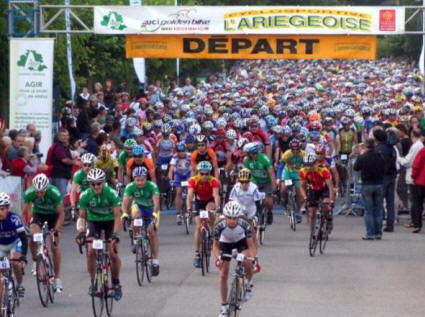Electro-Chemical Warfare...
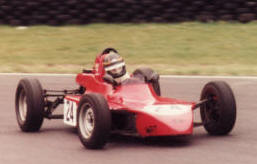 As
strange as it may seem, I don't think I'm your usual, stereotypical
obsessive, compulsive cyclist.
As
strange as it may seem, I don't think I'm your usual, stereotypical
obsessive, compulsive cyclist.
I ride my bike because I'm too old, skint, and slow (read talentless) to drive cars fast for a living.
When I was driving, I did everything I could to understand how the cars worked and why they behaved like they did. I used this understanding to help me make the cars faster.
As you can see, I now write cycling related stuff. So obviously I didn't understand enough. But now I have more time on my hands, and still have an inquisitive mind.
So when on the bike, I like to know why I hurt like I do and what I can do to make it stop; or at least understand why the suffering is worth it.
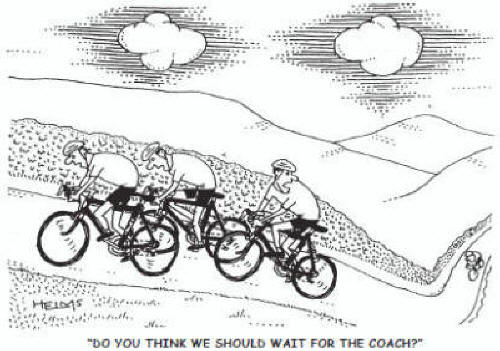
I now need all my reserves of stamina and willpower to propel my velocipede uphill and down dale. I need stamina, speed and endurance just to keep up, and fortitude, willpower and cunning guile, to mildly threaten some of the seriously talented riders in our Gunsite Grupetto and sometimes even further afield.
Which brings us to this factsheet on internal electro-chemical activity, external supplements and foodstuff ingredients. Hopefully this factsheet will help you understand why you feel like you do and what you can do to mitigate it, change it, or accept it when there's no other alternative.
Supplements ~ Part of your armoury or
slippery slope?
Yes, supplements and stuff. Somewhere, between a Vitamin C
tablet and EPO is a line that crosses between supplements and drugs. I don't even do supplements, but I'm sure they help others.
I eat well, (no processed food) I don't drink (I know! how boring)
and I go to bed early (to read).
I was once told, that if supplements worked they'd be banned. So you can assume that anything you can legally buy is either
marginally helpful (the placebo effect?), doesn't "really" work
(just train a little harder), or if it does work, it will soon be banned and probably isn't healthy for
you. The body, like your bike, likes to remain in balance.
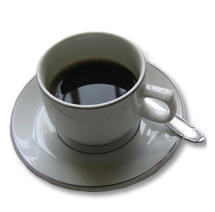
Lots of riders take the old Creatine, Sodium Bicarbonate, Iron tablets etc, but not me; not any more.
The only chemicals I have in my body are the natural ones I get on race day, and caffeine; which, it may surprise you, was on the WADA and IOC banned list until as recently as 2004.
I don't like coffee, I don't normally drink it, but on race day it's two mugs of the strong, black foreign stuff.
Once I've visited "the bathroom" (the fastest I'll probably move all day) we're good to go. Anyway, to the matter in hand...
Bonne Nuit
It's a firmly held belief that the pre-cursor to a good race is a
good night's sleep. Well I'm sorry to tell you it's not
strictly true. As the night before, the night before, is the
really important one.
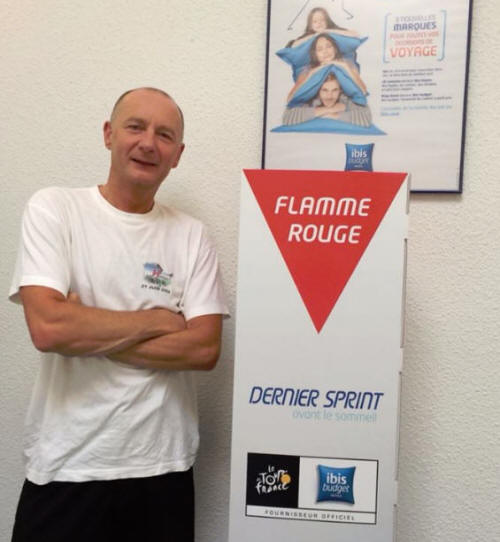
Sleep, is important ~ but not necessarily the night before
here we are at the ibis; just mention our name...
You can "get by" on just a couple of hours sleep and easily compete well the next morning. As anyone who's done the Marmotte, Ride London, or Gran Fondo new York, will tell you.
But still, Team Sky travel with each individual riders mattress and pillow to each event to ensure their precious cherubs get a good nights sleep. Because sound sleep is a vital part of the recovery process. It's not for tomorrow, it's for all the days after.
But you will "feel better" if you've had a good nights sleep before an event. See, that's the placebo effect again. Armed with the knowledge of this falsehood, the results of what happens next, and the reasons for your unsettled night, should make you a little more relaxed come race day.
Cumulative sleep deprivation is not good. A pre-night nerves, loss of sleep, is nothing to fret about in the morning. So don't talk yourself in to "having a bad day". It really, really, really isn't a problem.
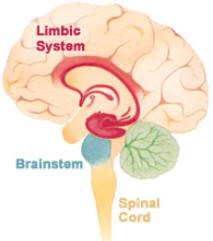 Primal Scream
Primal Scream
As
race day gets closer, the Limbic Brain (we have three parts to our
brain; Stem, Limbic, Neocortex) starts to become "active".
This "primal segment" of the brain is responsible for many things, but of our concern is it's role in emotion, motivation and behaviour. You may be more familiar with it as fight or flight syndrome.
As the race draws near, levels of the chemical, anabolic steroid hormone, testosterone, begin to rise within our bodies, causing a ripple (tsunami) of activity through our central nervous system.
Men have around seven times more testosterone than women. But they consume much more, to power growth, muscle development, etc, so their daily production is around twenty times higher than that of the fairer sex.
Testosterone improves performance as it enhances strength, endurance and muscle repair. It's a WADA, UCI and Olympic controlled substance and is easily detected, as exogenous (lab based) testosterone has less carbon-13 than the natural stuff.
Testosterone increases aggression and decreases risk assessment. Which is why young men are more likely to crash cars (and probably bikes) than any other demographic.
The night before a race, testosterone levels may be high enough to affect sleep. Even though testosterone raises confidence, it also elevates anxiety and that's never a good thing. We'll come to anxiety and worry later. For now, you just need to know why your body is in conflict.
Welcome to the Party...
So you managed to catch some
patchy sleep and probably even dreamt of
winning from a solo breakaway, by dropping everyone on the final climb. Even though
you're a sprinter!
And though you laid everything out nice and neat last night, you somehow can't seem to find anything this morning (again, we'll find out why, later). But somehow, you've managed to get yourself dressed and are ready to go down for breakfast. Although you really don't feel like any.
The conflict is now turning in to turmoil as the hypothalamus, and it's mates just above the brain stem, kick in to action and tell the Pituitary Gland at the base of the brain to pump cortisol in to your body.
Cortisol (hydrocortisone) is another steroid hormone and is released in response to stress. It increases blood sugar levels by aiding carbohydrate and fat metabolism. This is for fighting or flighting, but in our case we're going to channel it in to healthy competition.
So you see, cortisol induced turmoil is generally beneficial. However, a "side effect" of cortisol increase is that it draws neuromuscular reserves from elsewhere. Resulting in a decreased immune system, which is a bad thing. And just another reason why the Gunsite Gurpetto, and the pro's, don't do coffee stops!
You know you need to eat breakfast, but you really can't face it. You're going to have to because trust me, whatever you feel like now, the bonk is even worse. It's also know as "la fringale", but bonk has so much more of a childish humour quality to it, don't you think?.

Food Glorious Food
You can
easily tell the old, experienced hands at the breakfast table, they're the
loud ones laughing
and joking. Seemingly without a care in the world, they're normally getting on the nerves of
the "quiet" riders. Further ramping up
their self-inflicted pressure!
They do care, and they are just as pumped up as those around them. They just recognise it for what it is, a self-induced chemical reaction. Over time they've developed highly efficient coping strategies to work around it. Their body is in just as much turmoil as yours, they've just learnt through experience to enjoy it as part of their race prep!
They've also learnt that this air of anti-diffidence puts protagonists on the back foot; as we said, getting on their nerves, further ramping up their pressure! See, the gamesmanship has started already and we haven't even had our breakfast. So look and learn my young, anxious chums, look and learn. Age and experience have their benefits.
You're staring at the breakfast buffet, if on your travels; or the porridge bowl if at home. And really don't know what to do. The butterflies in your stomach are playing havoc with your normal routine.
 This is where the kidneys come in as an important part of your breakfast routine,
but not to eat!
This is where the kidneys come in as an important part of your breakfast routine,
but not to eat!
Sited on your kidneys are a pair of adrenal glands. These produce adrenal stuff, epinephrine, a doctor prescribed hormone for treatment of (amongst other things) cardiac arrest and asthma. We know it as adrenaline.
Adrenaline helps control contraction and relaxation of the smooth muscled heart and allows the cyclic production of AMP from ATP.
It also works, with insulin, to help convert glucose (the food sugar in carbs) to the sugar-based muscle fuel, glycogen; which is processed and held in the smooth muscled liver.
When epinephrine levels rise so does your body temperature, which leads to an increase in metabolic calorie consumption. Which itself causes the burning of precious fuel resources.
You've not eaten since last night and already nervous energy is eating at your dwindling reserves. So you need to eat!
Epinephrine also aids oxygen uptake as it's an excellent bronchodilator (used in asthma inhalers) but can cause high blood pressure. So again, another turmoil conundrum for your body to balance.

Do these boys look hungry?
The Hunger Dichotomy
The two main chemical hormones involved in appetite control are, Ghrelin and
Peptide YY. Ghrelin, discovered in 1999, is produced in the stomach and
pancreas it increases before meals, to make you
feel hungry.
Ghrelin = Appetite on! So that's a good thing.
Peptide YY activates during eating, or just before competition, in a timed release, to alert the brain you are full and to stop consumption.
It slows down gastric emptying to keep the food in the stomach to help aid digestion and increase nutrient absorption. It also sends notice to the colon to start absorbing water and electrolytes. Peptide YY = Appetite off! Which is normally good, but not before you've eaten!
Now, it's breakfast time, your body is hungry and craving food for its big event of the day. But you don't feel like eating because nerves, and other distractions flying around inside and outside your body, are overriding the Ghrelin signal.
Your job is to ignore these conflicting messages and eat a "normal" breakfast that you would on any big training morning, with maybe an extra round of toast and honey. Ignore the messages, eat through experience.
Negative energy balance is not conducive to having a good day. Especially when it's self-inflicted. So eat and drink as though your success depends on it. Because it does.
Another "reaction" to eating, is thermogenesis. Adrenaline is already elevating body temperature, now the food being processed in your body also causes raised core and skin temperature.
This is why half way through your breakfast you have to take off the fleece you put on because it was cold when you came down to eat!
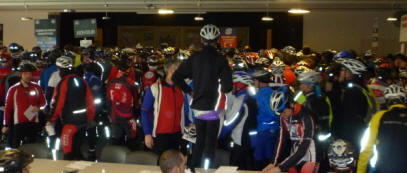
sign-on Belgian style
Ename Classic Sportive
Blood Sweat and Tears
Now we're signing on and the stress levels begin to rise. Number pinned on, pockets filled with food, helmet on, shoe covers
on, legs oiled up. Or is that just me?
Chemical warfare is now raging within your body. Heart rate is already elevated because your body is pre-warming itself for what's to come. Hopefully a warm up.
 Blood is directed away from
your non-essential peripheries to the important (running
away to survive) bits; the muscles, the heart and the
lungs.
Blood is directed away from
your non-essential peripheries to the important (running
away to survive) bits; the muscles, the heart and the
lungs.
Your skin cools and your core temperature rises. Blood is removed from your stomach, and fluids extracted from the digestive tract and nether regions.
This rapid movement gives the effect of "having butterflies" and wanting to go the toilet a lot.
In highly stressful events (where you think you're going to win, or get a bloody good hammering) the "flush" can be heavy enough to give you that sick feeling in your mouth.
Parts of the brain also have blood diverted to more "survival oriented" areas. This means your memory dips (why you can never find your keys), rational thought is compromised, and risk assessment is reduced.
Meanwhile, auditory and visual stimulation is increased to help you focus on the perceived threat and from where it might emerge.
Brilliant, just what you want at the start of your grand sportive. Six and a half thousand cranially and chemically challenged, caffeinated, cyclists, a 20 km race to the base of the first climb and an 80 kph descent. What could possibly go wrong?
The liver starts to ramp up glucose production and in keeping with their side of the bargain, the lungs open up alveoli to provide energy fueling oxygen while the increased heart rate provides this high-octane concoction at a greater volume to where it's needed; quad central.
Oh, and there's no tears. While blood pressure and body heat are rising, tear and saliva formation is inhibited. A dry mouth, which makes you drink more, could easily lead to drinking your precious bidon fluids wile waiting on the line.
If your going to be waiting at the start, always carry a 500 ml bottle to the line and keep it in your back pocket. Drink from it first then lose it at an early, appropriate, opportunity or a marshaled corner.
So once again, stick to your normal training preparation patterns. Don't be fooled by internal chemical reactions that lead you down false race-day paths. Just do what you normally do and you'll be okay.
The Ariegeoise ~ One of
the hottest races I've ever done!
Drunk 27 pints of fluid and it wasn't enough...
We're off...
To increase tension further, there's a ten second countdown! You fiddle nervously with your jersey zip,
straighten your helmet and fidget with your glasses. A cursory
check around bottles, gears, and a sharp pull of the brake levers
just for confidence. A quick glance at your heart
rate shows over 100 bpm, well it does for me.
Then you see someone do something and your memory is jogged. Your hand swings to the rear of your jersey to check for the food you've put there and already checked about six times. Phew, it's all there; still.
Slowly the line ahead moves forward and you're body begins to ramp up the adrenaline and cortisol levels to new heights.
Senses that were previously heightened become more concentrated. Hearing becomes narrower, extraneous sound is eliminated. In a racing car, you can almost hear the individual bearings whirring in the engine behind your head. The clarity is mind-blowing.
Peripheral vision narrows to a point that you are almost in a tunnel. I've raced in some spectacular places all over Europe and missed most of it, through being "in the zone". Which is why we always stay a day or two when racing away, to "explore the area" and see, ironically, the bits we missed when on our bike.
The ramped up adrenaline/cortisol mix allows free fatty acids to be used as fuel, sparing the high-octane glycogen for when it's really needed. We discussed encouraging this phenomenon in our "fat burner" factsheet.
We survive all the near misses of the braking, accelerating, surging compressions of the masses. Then five k in, remember to switch on our Garmin! How did we forget that? We swear at ourselves for being so stupid, until now, unaware of why it was out of our control.
Settle Down Now...
The early parts of any amateur race, no matter how long, are always
fast and furious. Pros start easy then ramp up, and up and up. The last hour of a pro race is always the fastest. For
"non-pros" it's normally the first hour. Go figure!
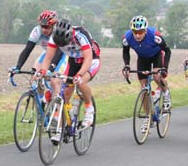
This is where you need to spend as little energy as you need, as conservatively as you can, to achieve your objective.
The energy available to you is precious and finite, treat it as such and never do any more than you really, really have to.
During the early stages, wheels have to be chased, gaps have to be closed and efforts have to be made that you really would rather not be making if it were left to you.
At times you will be required to go anaerobic (without oxygen) and will make call up on the three available energy systems in rapid succession.
Bang, Bang, Bang...
When you get out of the saddle to close that gap, you need
instantly available energy. You can't wait for metabolism and
oxygen delivery to catch up; this could be the winning break going
up the road.
So it's just as well, for emergencies such as this, you have a small, rapid response, explosive energy production system, stored neatly within the muscles themselves.
Another of our flamme rouge mantra's is, if you have to think about it, it's too late. You have a split second to react to opportunities or threats. Every half second you wait halves your chances of successfully getting across the gap or getting the wheel. When presented with an opportunity to excel, don't think, act!
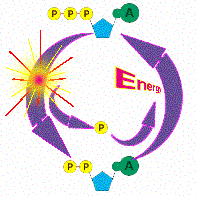
You have one hit, it's literally gone in a couple of seconds. But that's all the time we need to get on the gas. At the moment we're more concerned with quality than quantity.
The short-term ATP system kick starts the chase process while your body alerts the mid-term Phosphocreatine (PCr) System for action.
When the ATP system depletes, the PCr one will seamlessly take over.
The phosphocreatine system might just work for enough time to allow you to close the gap. You've got about twenty seconds to get on that wheel. If you can't, you need to go to Plan B (or is it now C?).
When the PCr system is exhausted, you need to (have to) throttle back and go to the third and final anaerobic energy process, the lactate system. Which is a whole different ball game.
We've covered these energy systems before, in a little more depth, in the Anaerobic Capacity factsheet.
Lactastic
We've previously busted a few myths about
lactate, so here we'll just concentrate on what's happening from
a chemical "in the moment" perspective.
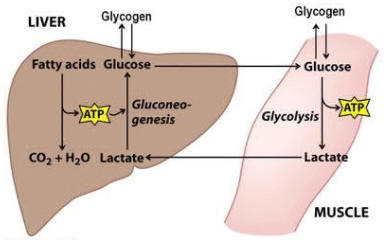
With ATP and PCr stocks depleted, the body begins to use the slower burning glycogen as a fuel. Which, without the presence of oxygen (we're still anaerobic), loses a pyruvate (the P in ATP) molecule and produces the pain daddy of them all, lactate.
We've had these conversations before, but lactate isn't all bad. At the right exercise intensity it's a fuel and allows you to stay away in an all day breakaway. But at higher levels it can become debilitating.
Another "bonus" chemical of choice, as a result of lactate drowning is the ubiquitous Hydrogen ions.
Because you are riding at your anaerobic limit you are inducing muscle cell oxygen deprivation and acidosis. This can be delayed by increasing your mitochondria density through the correct training programme, but at some point you will hit your ceiling. And when you do Hydrogen ions are the result.
Hydrogen ions are introduced by the body to maintain electro-neutrality in the muscles, but as a result they lower the ph balance, which causes "the burn" and a signal to the brain to "back off". Some people, for short time trials, take bicarbonate of soda as a buffer to pre-load the muscles and delay the shift of ph balance as long as possible.
Training correctly to raise mitochondria density has the same effect. It's cheaper, more fun and causes less "gastric distress"!
As you see from some of the recent dates in this article, we're still finding out about this stuff. But what we do know, as we've covered it before, is that pain and exhaustion are more likely a perceived issue in the brain rather than a physical exhaustion issue in the muscles.
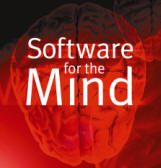 Brain
Override
Brain
Override
I know I've mentioned this elsewhere, but I used to do a lot of
"brain and thinking stuff".
I was working towards become an accredited De Bono practitioner, and developed a series of programmes called Software for the Mind. But life took another one of it's incredible turns.
The concepts are the same for us cycling pilots. A trained brain will always beat trained brawn. You just have to believe it enough.
Do not allow your internal fear or doubts, rob you of your courage, fitness or your wits. Programme the mind to ignore pain signals, there's loads of ways of practicing this in our Training Drills section.
At times of stress, when you believe you are at your physical maximum, and the bunch are still five seconds away, or the top of the climb is a kilometre ahead of you, it's so, so easy to listen to all the chemicals within your body that are sending your brain signals to desist from the activities and "back off".
We won't cover all the signals here, see the exhaustion factsheet for details, but your heart rate, breathing patterns, body heat, leg sensations, peer pressures, personal expectations, visual feedback and a multitude of other things, of which you are unaware, are all screaming at you to stop.
But then what? You stop hurting yourself and feel great for five seconds. Then the shame hits you. Could you of carried on? Pushed just a little bit more? Of course you could, you just chose not to.
 You need to train your
left brain to ignore these "logic feeds" and suffer the slings and
arrows of outrageous fortune. Take arms against your sea of
troubles and oppose them, to end them. Did Hamlet ride a
bike?
You need to train your
left brain to ignore these "logic feeds" and suffer the slings and
arrows of outrageous fortune. Take arms against your sea of
troubles and oppose them, to end them. Did Hamlet ride a
bike?
Blank out all external influences that do not support your objective of getting across the gap, or reaching the summit first. It can be done, you just need to believe in it enough.
Because if you think you can you can, and if you think you can't, you're right.
Okay, you've deactivated your left brain's pain receptors and switched on the right brain, to bury yourself and get across the gap. Then guess what? Everyone sits up!
After a brief outpouring of cycling induced tourette's, you realise you need to eat and drink.
Remember, your body is sending your brain conflicting chemical signals to inhibit your hunger, food digestion and liquid absorption. I know you don't feel like it, but do it anyway. Your success depends on it. So fuel up before the next onslaught begins.
It's now automatic pilot and cruise control until the last few kilometres when it all gets "jumpy" and the process above is repeated more times than you would like.

Pain Killers
Lots of highly ill-informed riders take NSAID's (non-steroidal
anti-inflammatory drugs) before a race. I'm only telling you
this because hearsay is a wonderful thing and the more times you
hear it the more you begin to believe it must be okay. It
isn't!
Drugs (because that's what they are) like aspirin and ibuprofen are a fantastic resolution to a host of issues. But sport isn't one of them, they're for medical use and you're not ill.
NSAIDs have been found to almost double the risk of heart failure; increase the prevalence of gastro-intestinal stress through internal bleeding; and can induce stomach ulcer perforation.
They also cause renal malfunctions as they interfere with the kidney blood flow and in men are up to 1.4 times more likely to cause erectile dysfunction. As if bike saddles weren't enough of a problem!
Your body has it's very own, highly effective and totally safe pain killers, endorphins. The word is a conjugation of endogenous and morphine.
Endorphins travel within the blood system and go looking for opiate receptors to latch on to and pair up with. Once together, they inhibit neurotransmitter release. They attach themselves to the spinal column for circulating in the spinal fluid, from where they can enter the brain. They can't get in to the brain through the blood channel itself.
 Endorphins, and the dulled pain sensations we experience, allow us
to push on for longer than we might do otherwise. This
extended period of pain excess, allows stage-two of the process to
open and allow anandamide to be released
in to our central nervous system.
Endorphins, and the dulled pain sensations we experience, allow us
to push on for longer than we might do otherwise. This
extended period of pain excess, allows stage-two of the process to
open and allow anandamide to be released
in to our central nervous system.
Anandamide, discovered in 1992, is a "relative" of the cannabinoid family, which is of course the main constituent in cannabis. It's also found in chocolate! It's now thought, from a 2003 study, that the "exercise high" we experience comes from anandamide.
Endorphins also encourage "inappropriate amounts" of dopamine to be released. Dopamine is a neurotransmitter (brain messenger) involved in the reward-motivation function and areas of arousal and pain.
It also acts on nearby cells to create a cascade response to other cells. Amongst the myriad of functions it has, circulating in the blood, it becomes a vasodilator, helping oxygen uptake at blood cell level.
Finally, although most of it is found within our stomach and intestines, intense exercise increases the rate and frequency of serotonin activation within the brain. Regular exercise boosts levels of the serotonin pre-cursor tryptophan, as do complex and starchy carbohydrates; or as we call them, "comfort foods".
All of this happens automatically, without any help or hindrance from your conscious thought; allowing you to just press the pedals and suffer well.
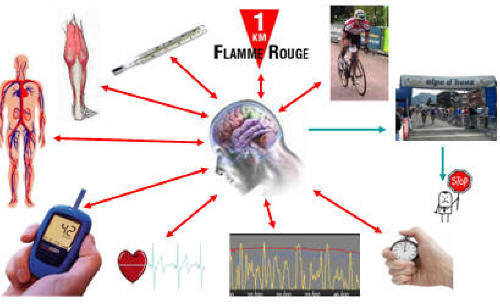
The Finale
As the flamme
rouge
approaches, the "stress" ramps up.
As we've seen, stress is just a set of electro-chemical stimuli from the body and the brain. The Limbic Brain fires up the Sympathetic Nervous System, which in turn agitates the General Adaptation Syndrome There are two ends to the stress spectrum; eustress and distress.
The General Adaptation Syndrome is too heavy for us here, but it's a recognised way the body deals, or doesn't deal, with stressors. It effectively consists of, react, resist/adapt, exhaust.
Eustress is good, it's the stress that enables you to "get the job done". Distress is the point (and condition that has many, many levels) were the ability to tolerate or cope with the level of stress, is overcome.
Eustress causes enough stimulation to enhance quality decision making, quickly and rationally assess risks, and more importantly, take immediate and positive action to affect a successful outcome.
Distress, is almost the polar opposite; indecisiveness, questionable risk assessment, almost always the wrong response which unsurprisingly results in a negative outcome. Stress is the cause and result of itself. It's a vicious, debilitating circle that only you can break.
Where you sit on this spectrum is dependent on you, time, environment, the conditions prevalent, the number and level of stimuli and perception of previous outcomes. In other words, as we spoke of earlier at the breakfast table, experience is a great diffuser of stress.
For a sprinter; a two up, straight run-in sprint, on a nice day, when you're with a climber, has less stress stimuli than a full on bunch sprint, in the rain, with no teammates around you and a ninety degree corner 400 metres from the line. So stress is a relative concept.
The Prevalence Effect
 The past has
happened, you can't change it, so ignore it.
The past has
happened, you can't change it, so ignore it.
The future has yet to happen; you can influence it, but for now, it's of no concern, again, just ignore it.
Determinism is a branch of philosophy that primarily relates to cause and effect. As we approach the end of the race, you want to be the cause, not the effect.
Too many people live in the past and the future. People worry about the past and become anxious of the future. It's human nature. Just as in life, it is as in racing. Don't worry about how you performed last time, or be anxious of what might happen this time. These are right brain issues.
We now need to do another conscious brain switch! Now we need to switch off the right brain and get back to the logical left brain way of doing things. Hardwire your brain, and the electrical impulses in it, to live in the moment. Shut down the right brain and its limiting beliefs.
Don't let the burdens of past results, or outcomes, create obstacles to your future results and outcomes. Influence the change.
You need to concentrate on the now and affect the outcome through your logical, decisive actions or reactions. Stay near the front. Use your heightened auditory and visual senses to be aware of what might and probably will happen. And if nothing happens, make it happen. You're a racer, so race!
There are three types of people in this world, those that let things happen, those that make things happen and those that say "what happened". It's your turn to make things happen.
We've done visualisation techniques before and our good friend Richard Evans produced a fantastic factsheet for us. This is where the trained brain can really overcome the shortcomings of yourself, or the perceived advantages of others. Neglect it at your peril. Embrace it and success is there for the taking.
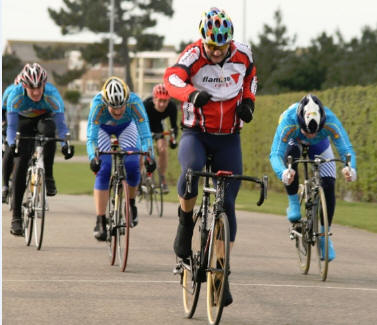
In a forthcoming factsheet we'll cover the post-event rituals for enhancing the recovery process and the chemical aftermath of a good job well done.
The Message
Tension, nerves, anxiety and stress are all chemically driven,
emotional responses to a pre-determined, personal template that's
yours and yours alone. Your job is to recognise this and take
control of it. Because if you don't, it will control you, your
actions, responses, outcomes and success.
It can start as simply recognising the fact that you believe you're not hungry at breakfast. But you have been for the previous three months getting ready for the event. Just eat as you would for your big training rides. Override the signals coming from the brain.
We can't do anything about these electro-chemical signals, it's hard wired in to our systems. But we can be aware of them and make a physical adaptation to our responses.
As we said earlier, you don't feel hungry but you have to override your feelings and "force" food in to your body. Even though it's apparently telling you don't need it.
During the event, eat and drink regularly, even if you have to set your Garmin (or gadget of choice) to remind you by beeping every ten minutes.
Your body cannot tell the difference between an imagined scenario and a real one. it will react the same to both situations. If you don't believe me read a mucky book (or a scary one) and see what happens!
If you really have problems shaking off nerves, or making things happen, imagine your writing a book. Everything that's happening is happening to someone else, not you.
But there's one thing you can be sure of, everyone around you is experiencing the same sensations, it just those that handle it the best will prevail. Make sure you're at least in with a chance.
And if it doesn't go to plan this time? Have some chocolate...

